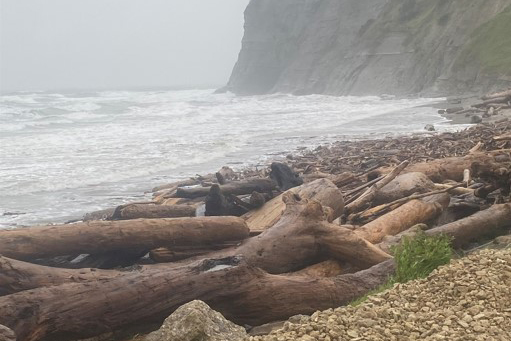Hawke’s Bay Regional Council is removing nearly 150,000 tonnes of woody debris from Hawke’s Bay rivers and catchments, 17,500 of that in Wairoa, allowing popular beaches to be safely accessed again, reducing risk of wood remobilising as well as mitigating the fire risk across the region.
Council is now spending $4 million received from MPI to remove a minimum of 40,000 tonnes of woody debris from the upper catchments in the region.
The Council used aerial surveys to identify and prioritise high-risk catchments including Waipawa River, Mangaone River, Aropaoanui River, Esk River, Mangakapikopiko Stream, and Wairoa River.
Regional Council’s Anna Madarasz-Smith said removal of woody debris was crucial to prevent any further damage to infrastructure and local communities throughout the region.
“Cyclone Gabrielle caused a number of land slips, which brought down trees that are near the edges of waterways or in the rivers. Now, it’s incredibly important we work quickly to safely remove what we can to reduce risk of any further damage in another rain event,” Madarasz-Smith said. “With funding from Ministry of Primary Industries, we are shredding and burning the debris, including heli-burning high in the Waipawa River catchment.”
Work on the clearing began in June 2023 and is expected to be completed by May 2024.
The Silt Recovery Taskforce Lead Darren de Klerk said this work was key to allowing the community to access recreational areas safely and prevent wood remobilising or becoming a fire hazard.
“We’ve managed 150,000 tonnes of wood around the region, either stacking it into piles, chipping/ shredding or burning. This allows the beach to be used for recreational use again and prevents the debris being swept back out to sea,” de Klerk said.
“We know there is still a significant amount of woody debris out there, with a significant amount of that being along the coast between Waikare and Māhia.
“We’re very aware of the concern in the community, particularly where it could build up at river mouths and beaches, and the need for this work to continue. We’re working with the Regional Recovery Agency and Hawke’s Bay councils to support our community and continue to seek further funding from Government.”
But bad news from Wairoa
Progress made by the Silt Recovery Taskforce team to remove woody debris has been hampered in Wairoa, with the district being hammered by constant rain.
More than 300mm of rain fell over last weekend in some parts of the district, isolating rural communities with more than 30 people blocked in. Around 20 roads across the district are closed, with crews working to punch through and restore access where possible. An Emergency Operations Centre was set up, with staff checking on local and rural residents, and an evacuation centre was set up at the War Memorial Hall, but it was not needed.
Silt Recovery Taskforce Lead Darren de Klerk said the team were making good headway and worked along the coast at Māhia, Opoutama, Taylor’s Bay, and other beaches.

“This has been set back by the recent rain. The additional rain over the weekend means that more wood has washed up along rivers and beaches, particularly at Māhia beach and Kopu Road flats, which means we’ll have more work to do,” he said.
“Our focus is to get the beaches open and safe for the community over summer. 150,000 tonnes of woody debris have been shifted so far. When we shift the wood, we are aiming to move it away from the high tide on beaches or off riverbanks beside rivers where it could remobilise and cause damage.”
$1.5m from the Sediment and Debris Fund has been allocated to the Wairoa District.
Wairoa Civil Defence Controller Juanita Savage said the district could use a break from Mother Nature.
“Heavy rainfall on already saturated ground has significantly impacted our rural communities with massive slips and access issues. Rural communities are suggesting the slipping and damage to land is greater than Cyclone Gabrielle,” said Savage.
She said river and surface flooding impacted the township and immediate surrounding areas with some properties affected for the third time this year. “At this early stage, two homes have been identified as yellow/partial restriction as a result of Rapid Building Assessments. More assessments are still to be carried out,” Savage said.
Wairoa Mayor Craig Little said it was unbelievable that Wairoa has been hit by extreme weather again.
“Farming is the backbone of our community, and it has been significantly impacted. This is particularly difficult as some farms were just recovering from previous events, and their repair work of fencing and tracking has now been undone,” Little said.
Public Interest Journalism funded by NZ on Air

